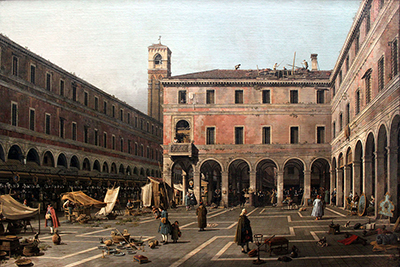In the painting The Campo de Rialto the artist shows one of the classic city views that became the hallmark of his work. Commonly known as Canaletto, the artist Giovanni Antonio Canal was born in Venice in 1697, and in this Venetian city scene he captures the striking buildings and details of everyday life to perfection.
Studying with Luca Carlevarijs who was a renowned cityscape painter, Canaletto quickly became the equal of his tutor. Although Canaletto's early artwork was painted outdoors in contrast to undertaking the painting in a studio, which was the painting tradition of the time, some of his later works were painted indoors. In The Campo de Rialto the artist takes what could be a dry subject and brings it alive by his attention to detail. The viewer is drawn into picture to observe the minutiae of daily life, such as the small dog and the activities in the foreground, and then further back the men mending a roof. Canaletto's early life was characterized by a different form of art as he followed his father into his occupation of theatrical scene painting, and he was later inspired by the Giovanni Paolo Pannini whose style incorporated scenes of daily life in the city. Following on from that, the Venetian would himself inspire others right across Europe, with the entire genre of landscape art building a much stronger momentum having been relegated to the status of a niche interest in previous centuries.
Following Pannini's lead, Canaletto began his own paintings of outdoor scenes in and around his home city of Venice, and this included classic scenes of the Grand Canal and other less obvious subject matter such as that in The Stonemason's Yard. The latter depicts a more humble side of the city away from the grandeur of the classical scenes and architecture. The painting is an oil on canvas and was painted somewhere between 1758-63 and is now housed in the Staatliche Museen in Berlin. The painting is somewhat austere in style and belongs to one of a group of four that were commissioned by a German merchant, Sigmund Streit. The painting shows the Ruga degli Orefici, the Pasazzo dei Dieci Savi and the campanile of San Giovanni degli Elemosinario in the background. The building at the centre and to the right of the painting is the Fabriche Vecchie di Rialto.
The early works of Canaletto remain his most treasured and many have argued his best. His landscapes of the pageantry and traditions of his city painted on a large scale convey a strong sense of the traditions and activities of his time. By using vibrant local colours and atmospheric effects, some art critics have said that his artwork may be said to have paved the way for the impressionist movement and there was certainly an element of self-expression which was key to several art movements which followed in the centuries after his career. The route to Impressionism was made via the Romanticists, and Canaletto undeniably helped to promote the cause of landscape art that previously had been treated as more of a supportive element to other genres, such as portraiture or history painting. It was the impact of all of these artists which established it as a major force in its own right and today it can be considered perhaps even the most popular genre of all.




